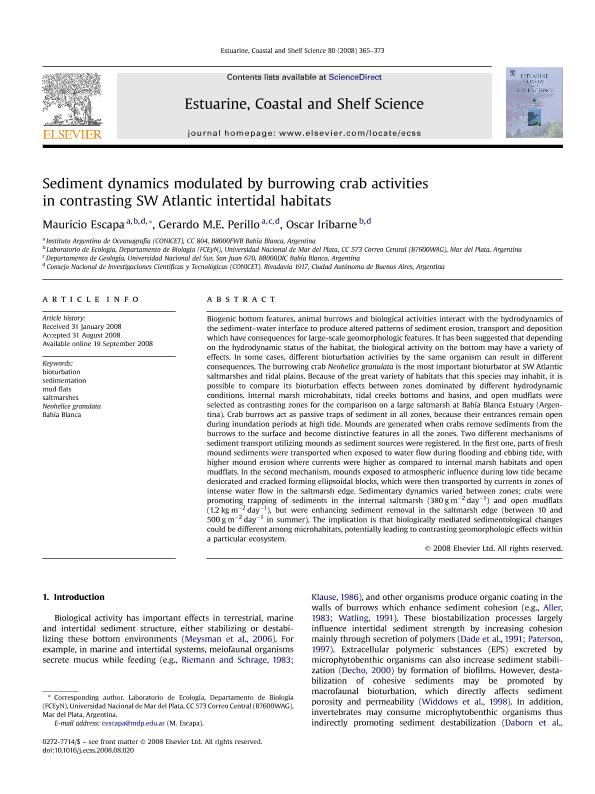Mostrar el registro sencillo del ítem
dc.contributor.author
Escapa, Carlos Mauricio

dc.contributor.author
Perillo, Gerardo Miguel E.

dc.contributor.author
Iribarne, Oscar Osvaldo

dc.date.available
2017-11-07T17:45:32Z
dc.date.issued
2008-11
dc.identifier.citation
Escapa, Carlos Mauricio; Perillo, Gerardo Miguel E.; Iribarne, Oscar Osvaldo; Sediment dynamics modulated by burrowing crab activities in contrasting SW Atlantic intertidal habitats; Academic Press Ltd-elsevier Science Ltd; Estuarine, Coastal and Shelf Science; 80; 3; 11-2008; 365-373
dc.identifier.issn
0272-7714
dc.identifier.uri
http://hdl.handle.net/11336/27750
dc.description.abstract
Biogenic bottom features, animal burrows and biological activities interact with the hydrodynamics of the sediment–water interface to produce altered patterns of sediment erosion, transport and deposition which have consequences for large-scale geomorphologic features. It has been suggested that depending on the hydrodynamic status of the habitat, the biological activity on the bottom may have a variety of effects. In some cases, different bioturbation activities by the same organism can result in different consequences. The burrowing crab Neohelice granulata is the most important bioturbator at SW Atlantic saltmarshes and tidal plains. Because of the great variety of habitats that this species may inhabit, it is possible to compare its bioturbation effects between zones dominated by different hydrodynamic conditions. Internal marsh microhabitats, tidal creeks bottoms and basins, and open mudflats were selected as contrasting zones for the comparison on a large saltmarsh at Bahı ́ a Blanca Estuary (Argen- tina). Crab burrows act as passive traps of sediment in all zones, because their entrances remain open during inundation periods at high tide. Mounds are generated when crabs remove sediments from the burrows to the surface and become distinctive features in all the zones. Two different mechanisms of sediment transport utilizing mounds as sediment sources were registered. In the first one, parts of fresh mound sediments were transported when exposed to water flow during flooding and ebbing tide, with higher mound erosion where currents were higher as compared to internal marsh habitats and open mudflats. In the second mechanism, mounds exposed to atmospheric influence during low tide became desiccated and cracked forming ellipsoidal blocks, which were then transported by currents in zones of intense water flow in the saltmarsh edge. Sedimentary dynamics varied between zones; crabs were promoting trapping of sediments in the internal saltmarsh (380 g m 2 day 1 ) and open mudflats (1.2 kg m 2 day 1 ), but were enhancing sediment removal in the saltmarsh edge (between 10 and 500 g m 2 day 1 in summer). The implication is that biologically mediated sedimentological changes could be different among microhabitats, potentially leading to contrasting geomorphologic effects within a particular ecosystem.
dc.format
application/pdf
dc.language.iso
eng
dc.publisher
Academic Press Ltd-elsevier Science Ltd

dc.rights
info:eu-repo/semantics/openAccess
dc.rights.uri
https://creativecommons.org/licenses/by-nc-sa/2.5/ar/
dc.subject
Bioturbation
dc.subject
Sedimentation
dc.subject
Mud Flats
dc.subject
Saltmarshes
dc.subject
Neohelice Granulata
dc.subject
Bahía Blanca
dc.subject.classification
Meteorología y Ciencias Atmosféricas

dc.subject.classification
Ciencias de la Tierra y relacionadas con el Medio Ambiente

dc.subject.classification
CIENCIAS NATURALES Y EXACTAS

dc.title
Sediment dynamics modulated by burrowing crab activities in contrasting SW Atlantic intertidal habitats
dc.type
info:eu-repo/semantics/article
dc.type
info:ar-repo/semantics/artículo
dc.type
info:eu-repo/semantics/publishedVersion
dc.date.updated
2017-10-30T18:34:34Z
dc.journal.volume
80
dc.journal.number
3
dc.journal.pagination
365-373
dc.journal.pais
Países Bajos

dc.journal.ciudad
amsterdam
dc.description.fil
Fil: Escapa, Carlos Mauricio. Consejo Nacional de Investigaciones Científicas y Técnicas. Centro Científico Tecnológico Conicet - Bahía Blanca. Instituto Argentino de Oceanografía. Universidad Nacional del Sur. Instituto Argentino de Oceanografía; Argentina. Universidad Nacional de Mar del Plata. Facultad de Cs.exactas y Naturales. Departamento de Biología. Laboratorio de Ecología; Argentina
dc.description.fil
Fil: Perillo, Gerardo Miguel E.. Consejo Nacional de Investigaciones Científicas y Técnicas. Centro Científico Tecnológico Conicet - Bahía Blanca. Instituto Argentino de Oceanografía. Universidad Nacional del Sur. Instituto Argentino de Oceanografía; Argentina. Universidad Nacional del Sur; Argentina
dc.description.fil
Fil: Iribarne, Oscar Osvaldo. Consejo Nacional de Investigaciones Científicas y Técnicas; Argentina. Universidad Nacional del Sur; Argentina
dc.journal.title
Estuarine, Coastal and Shelf Science

dc.relation.alternativeid
info:eu-repo/semantics/altIdentifier/doi/http://dx.doi.org/10.1016/j.ecss.2008.08.020
dc.relation.alternativeid
info:eu-repo/semantics/altIdentifier/url/http://www.sciencedirect.com/science/article/pii/S0272771408003375?via%3Dihub
Archivos asociados
